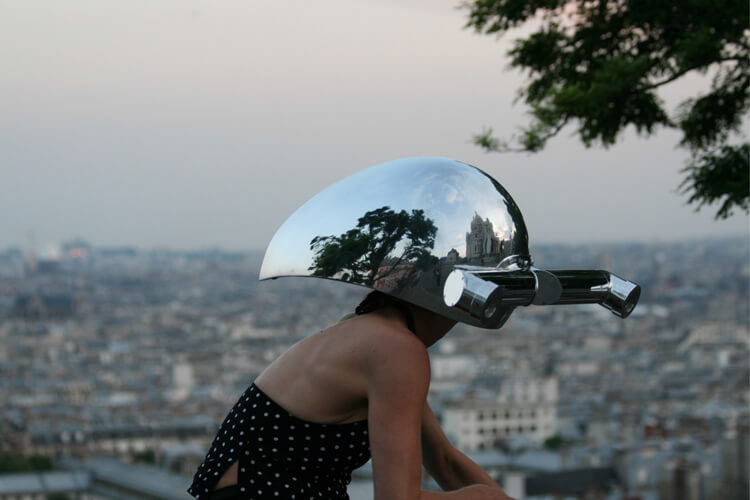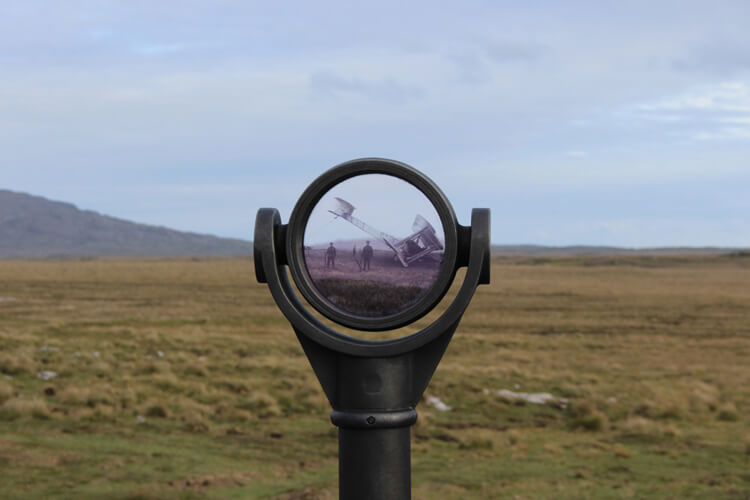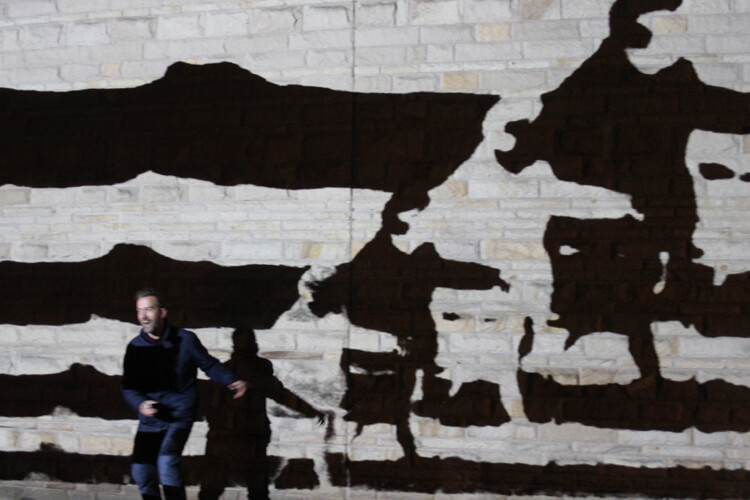Interview by Ana Sancho

The work of artistic couple Anne Cleary and Dennis Connolly revolves around the intriguing art of looking. According to them, how we look at the world and how we understand it, each of us from our particular perspective is central to what we are as human beings. In addition to our eyes, they argue that our mind and body are also involved in the act of looking, and they make sure their work reminds us of the complexity of this process.
Having both graduated in architecture in Dublin, Anne Cleary and Dennis Connolly moved to Paris in 1990. At that time, Paris was an exciting place to be. They started to hang out with performance and sound artists who would later influence their work. Working as freelancers gave them the opportunity to explore and engage in creative practices. Over time, the couple has gained a well-deserved international reputation as new-media artists.
The couple’s new work, Less than Thirteen (2017), explores visual space perception and the relationship between movement and musical expressivity. Commissioned by The Barbican and the London Symphony Orchestra (LSO), Less than Thirteen marks the beginning of Sir Simon Rattle as the new music director of the LSO. The digital artwork is a large-scale silent projection of the director’s movements conducting the orchestra. This visualisation not only challenges Gunnar Johansson’s theories of motion perception, which showed that a human body could be represented by just thirteen moving points, but also our entire perception of human movement.
With Metaperceptual Helmets (2014), the artists invite the audience to engage in experiences with different types of visions. The helmets emulate the 360-degree vision of the hammerhead shark or a horse’s peripheral vision with the front-end blind spot, among others. The different designs examine how the human brain can adapt to new visual information and the possibility of seeing the world differently.
By integrating innovative technology into their work, the couple experimented with our ability to take what is available to our eyes and transform it into meaningful input. The spectators are left with our interpretation of the surrounding environment.


You are both architects by training, and your artistic practice usually incorporates technology focusing on sensorial experimentation. How and when did the interest in them come about?
It came about in 90s Paris. We were still architects but drifting towards computer-generated imagery and new media in general. There were a few alternative spaces (Galerie eof, the InFact squat, the “Batofar”…) that were doing live performance evenings. A bunch of people of all nationalities were making live music with MAX (or Max MSP as it was known then). It was just becoming possible to take on live imagery, and we were the only people who worked with video cameras, so we quickly became the video people.
At the start, we kept it very simple: projecting feedback from live cameras, fading from one camera to the other, pushing up colour and contrast… But then we started adding some time delay, swapping colour channels about, mixing live and pre-recorded video from the same fixed camera, superimposing negative and positive feed… until we realised that this was all quite interesting!
You are presenting a new digital installation for the Barbican, Less than Thirteen, which is based on motion capture of the world-class conductor Sir Simon Rattle’s movements and drawing on Gunnar Johansson’s theories of motion perception. Could you tell us about the intellectual process behind it?
A few years back, we were introduced to Johansson’s work on motion perception by a scientist friend, Sally Duensing, who tragically died in 2015. Two things intrigued us. The first was how little information is needed to distinguish a human figure in motion: a few dots become undeniably human once they trace a human movement. The second was how technologically and graphically simple Johansson’s experiments were. They were mostly done in the 70s, before sensor technology or big tech firm/university/CGI budgets.
It encouraged us to participate in motion capture, which was mostly beyond our means. Johansson wanted to see how few dots he could reduce a human figure to without it losing its full humanity. The magic number he discovered was thirteen. If this number was a threshold, it was not one that it was forbidden to go below. Less than thirteen dots challenges the mind to reconstruct the human figure from what might first appear as a machine-like or planetary movement. Like with any reductive work of art, the mind tends not to accept abstraction, and the revelation of the partially perceived human figure can be quite an extraordinary visual experience.
You have collaborated with artists from other disciplines, particularly dancers, writers or musicians, in many of your projects. Which one do you feel has been your most challenging project-either intellectually or technically- so far?
It would have to be Less Than Thirteen. We’ve certainly never worked with a performer who can compare with Sir Simon Rattle, and we’ve never been able to work before with the quality of mo-cap data that the Portsmouth University team produced. We had a clear ambition that we stated from the beginning: limit ourselves to a series of simple studies of Rattle’s movements using as few dots as possible.
We wanted to share the delight we had experienced ourselves in conjuring the performer’s body from just a handful of moving dots. Doing simple things well can be remarkably difficult. Luckily, our commissioners from LSO (Edward Appleyard) and The Barbican (Sidd Khajuria) were very supportive and enthusiastic throughout, and we had an excellent producer in Anthony Gray.
Your work is always participatory in its creative process and final engagement with the spectator. You even coined the term “observer participation” to describe your work, affirming that an artwork is not just an observation of the world but an active involvement in the world. What do you expect from the viewer interacting with your installations/pieces?
The Observer is perhaps what the hunter-gatherer-that-we-were has been becoming for millennia. It is important for us that the spectator’s perception is central to the work. That is essentially the logic of our Meta-perceptual Helmets: the spectator puts on the helmet and looks back out at the world through it, effectively becoming the art. It’s not so much about exploring other ways of seeing so much as laying bare the processes of looking that we take for granted. Perhaps the most important thing is that looking is not just about eyes: it involves both mind and body.
We look with our whole bodies, which move around the object of our gaze while our heads turn about, and we take things in our hands to examine them more closely. When we look, our mind is working, interrogating the world, filling in colour and detail that we have barely glanced at, and building models using current and remembered sensory data. In Less Than Thirteen, It is the mind of the spectator that builds a moving human figure. The eyes only see dots.
The incorporation of interactive technology is central to your practice. How people respond to multiple stimuli in a digital environment beyond the touch of a screen or button is one of the questions to answer in this 21st century in which people live in a hyper-connected society. In which ways do you think are interactive and digital technologies changing or affecting human behaviour?
In fact, we use much less interactive technology now than we used to (if by interactive, you mean digital interfaces). Of course, we would argue that the Meta-perceptual Helmets are nevertheless profoundly interactive because they ask the spectator to become so active, and they create a perceptual loop between artwork and spectator. Nevertheless, there are no electronic components in any of the helmets (so far).
When we first started working with Johansson’s dots, we wanted them to be interactive, using a Kinect with software that created live dot figures from spectators’ moving bodies. But the arm-waving that the Kinect installation inevitably invited was somehow just distracting from a more important process that was going on in the visual cortex of the spectator: drawing human bodies out of an almost abstract play of moving dots. In a way, we’ve discovered – and we’re not the only ones – that art is always interactive and always has been.
What is your chief enemy of creativity?
Money worries! They can be paralysing. It’s all very well to say ‘you’ve got to stay hungry’, but making art takes time, and unfortunately, it doesn’t always put food on the table.
You couldn’t live without…
…each other!






